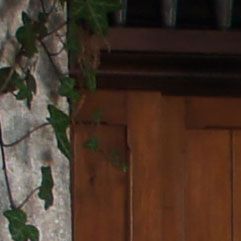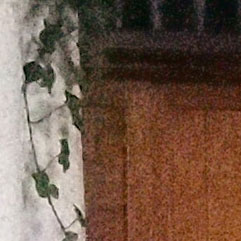Panasonic Lumix DMC-GF3
-
-
Written by Gordon Laing
Quality
Panasonic Lumix GF3 vs Sony Alpha NEX-C3 vs Olympus Pen E-PL3 image quality
|
Panasonic Lumix GF3 |
Sony NEX-C3 |
Olympus Pen E-PL3 | ||
 |  |  | ||
f5.6, 160 ISO |
f5.6, 200 ISO |
f5.6, 200 ISO | ||
 |  |  | ||
f5.6, 160 ISO |
f5.6, 200 ISO |
f5.6, 200 ISO | ||
 |  |  | ||
f5.6, 160 ISO |
f5.6, 200 ISO |
f5.6, 200 ISO | ||
 |  |  | ||
f5.6, 160 ISO |
f5.6, 200 ISO |
f5.6, 200 ISO |
Panasonic Lumix GF3 vs Sony AlphaNEX-C3 vs Olympus Pen E-PL3
Noise
The above shot was taken with the the Panasonic Lumix GF3 in Program auto mode. The 14-42mm f3.5-5.6 kit lens was set to its maximum wide angle 14mm (28mm equivalent) setting, the sensitivity was set to 160 ISO and the exposure was 1/2 of a second at f3.5. The crops are taken from the area marked with the red square and presented below at 100%. The Lumix GF3 has a base ISO sensitivity of 160 ISO (a notch up from the 100 ISO of the GF2) giving it potential for a slight edge over the NEX-C3 and E-PL3, and indeed the 160 ISO crop does look ever so marginally cleaner than at 200 ISO. But it is marginal and both the 160 and 200 ISO crops show a good degree of detail with little evidence of noise. At 400 ISO there’s both a little graininess and some smoothing beginning to creep-in, most evident in the vertical lines of the wood panelling. At 800 ISO the noise is becoming more apparent, but there’s still excellent retention of detail and the overall image quality is well within acceptable limits. The GF3 strikes a very good balance here at what is for many sensors a critical boundary. Certainly anyone used to shooting with a compact who might hesitate to push the dial beyond 400 ISO need have no such qualms with the GF3. The same, regrettably, can’t be said of the step up to 1600 ISO where the noise is now beginning to have quite a significant effect on image detail. Though it’s worth pointing out that at less than 100 percent magnification 1600 ISO shots form the GF3 are perfectly passable. Even the 3200 ISO crop, though almost everything is obscured behind a cloud of noise, is useable for those must have in any circumstances shots. There’s no getting away from the fact that the 6400 ISO crop is more noise than actual image data but, in the absence of any low-light composite modes it might be worth a try. Again, anyone moving up from a compact which might, at best, offer a reduced resolution higher ISO option will regard this as an embarrassment of riches. Compared with the Sony NEX-C3 the Lumix GF3 crops start out well. At the lower ISO sensitivities there really isn’t a great deal in it – indeed if anything the NEX-C3 crops look a little softer than those from the GF3. But as you climb the sensitivity range the NEX-C3’s bigger sensor advantage becomes more and more apparent. At 400 ISO the Sony crops, though still a little softer than the GF3’s nonetheless show a little more detail and at 800 ISO where noise is making a clearly visible impact on the GF3, the NEX-C3 is still keeping it well in hand. But it’s in the mid to high range where the NEX-C3s advantage really begins to tell and at 3200 ISO there’s at least a stop of difference between the high ISO noise performance of the two sensors. The Olympus Pen E-PL3 metering opted for slightly longer exposures than both the Lumix GF3 and NEX-C3 and as a result its a little easier to see the detail (and the noise) in the E-PL3 crops. At the 200 and 400 ISO sensitivity settings the Pen E-PL3 crops look pristine and at 800 and 1600 ISO still have a clear and significant edge over the GF2. Beyond that, things even up a bit, but over most of the ISO sensitivity range the Pen E-PL2 is a clear winner over the Lumix GF3. Another thing worth bearing in mind if good low light performance is important to you is that the NEX-C3 has two composite low light modes shown in the final two crops. Hand-held Twilight and AntiMotion Blur both provide a significant improvement in image quality over what you’d get in a single-shot mode with a high ISO setting. We’ve included the Pen E-PL3’s (non-composite) DIS low light mode for comparison. Overall, the GF3 turns in some good results here, but is out-performed on noise levels by its two rivals. We can’t help but wish Panasonic had equipped the GF3 with the superior sensor from the G3, although to be fair this in turn would have increased the price. Now head over to our Panasonic Lumix GF3 sample images to see some more real-life shots in a variety of conditions.
|






























